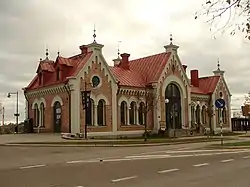Hudiksvall Municipality
Hudiksvall Municipality (Hudiksvalls kommun) is one of Sweden's 290 municipalities, situated in Gävleborg County, east central Sweden. Its seat is in the city Hudiksvall.
Hudiksvall Municipality
Hudiksvalls kommun | |
|---|---|
 Hudiksvalls Train Station | |
 Coat of arms | |
 | |
| Country | Sweden |
| County | Gävleborg County |
| Seat | Hudiksvall |
| Area | |
| • Total | 4,516.62 km2 (1,743.88 sq mi) |
| • Land | 2,488.89 km2 (960.97 sq mi) |
| • Water | 2,027.73 km2 (782.91 sq mi) |
| Area as of 1 January 2014. | |
| Population (31 December 2019)[2] | |
| • Total | 37,607 |
| • Density | 8.3/km2 (22/sq mi) |
| Time zone | UTC+1 (CET) |
| • Summer (DST) | UTC+2 (CEST) |
| ISO 3166 code | SE |
| Province | Hälsingland |
| Municipal code | 2184 |
| Website | www.hudiksvall.se |
The present municipality was formed in 1971 when the City of Hudiksvall was amalgamated with four surrounding rural municipalities. Minor amalgamations had also taken place in 1952 and 1965, reducing the number of local government entities in the area.
Localities
Figures as of 2000, from Statistics Sweden
- Hudiksvall 15 325 (2002)
- Iggesund, 3444
- Delsbo, 2284
- Enånger, 724
- Friggesund, 599
- Sörforsa, 1540
Geography
Distance to large towns: Stockholm 305 km, Gävle 130 km, Sundsvall 84 km.
Transportations are easy by the European route E4 highway, and the East Coast Railway (Ostkustbanan).
Industry
The largest employer is the municipality and the county council, where around 38% of the work force have its work place.
The largest private employer is the paper product company Holmen where about 10% of the work force work.
In the old history, the industry was dominated by fishing. In the 19th century the forest industry came to dominate, further enhanced by the improved transportations which the rail roads provided in the second half of that century. Although in decline during the 20th century, half of the municipal industry is still based around forest industry.
Employees per sectors:
- Pulp, paper, and paper goods: 29%
- Machine technical industry: 20%
- Electronics 19%
- Metal products: 8%
- Wood products 7%.
The electronics industry is dominated by Ericsson Network Technologies making optical and copper wires for telecommunication systems. (Sources: ,Holmen.com)
References
- "Statistiska centralbyrån, Kommunarealer den 1 januari 2014" (in Swedish). Statistics Sweden. 2014-01-01. Archived from the original (Microsoft Excel) on 2016-09-27. Retrieved 2014-04-18.
- "Folkmängd i riket, län och kommuner 31 december 2019" (in Swedish). Statistics Sweden. February 20, 2020. Retrieved February 20, 2020.
External links
- Hudiksvall - Official site